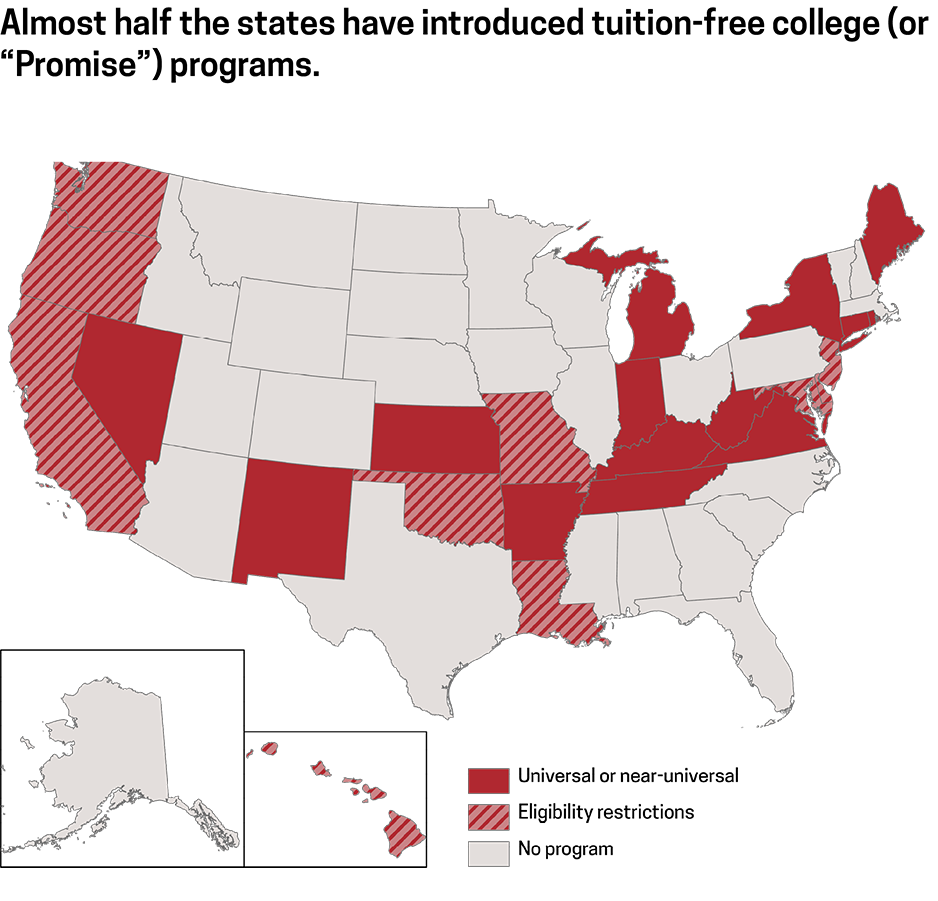
This research highlight is part of the recently-released annual report of the Institute's "Promise: Investing in Community" major research initiative.
by Michelle Miller-Adams
Policy Recommendations
-
Place-based tuition-free (or “Promise”) programs should be designed with the needs and assets of a given locality in mind.
-
Keep program rules simple to broaden access; be sure to invest in communication.
-
Build on best practices in navigation and support services to help students access and complete degrees and credentials; effective support is critical for promoting economic and racial equity.
-
Bring relevant partners to the table early on; Promise programs are inherently collaborative enterprises.
Watching the Biden Administration’s free community college plan shrink and then disappear from congressional budget negotiations in the fall of 2021, one might have mistakenly concluded that the free-college movement in the United States had come to a halt. In fact, progress did not stop when federal action stalled. Instead, the spotlight shifted back to states and localities where innovation around tuition-free college had been occurring all along.
In the past year, several states, cities, and institutions have introduced tuition-free college (or “Promise”) programs of their own, while others have revised eligibility requirements to include more students. This continued momentum is represented in the many states (see map) and more than 200 localities where broadly accessible tuition-free college programs are operating.

Two free-tuition programs introduced recently bear a closer look. The New Mexico Opportunity Scholarship is the most flexible and generous of any statewide Promise initiative. The Columbus Promise is a lower-cost local endeavor that provides a new model for the Promise field. Both embody key lessons learned from more than a decade of state and local innovation around free college.
What are these lessons?
-
Simplicity in program design and effective communication about program benefits are essential components of a successful Promise program. Streamlining the process of learning about postsecondary options and accessing financial aid can be as important for broadening access to higher education as the funding offered by Promise programs.
-
Program design matters. Choices about key parameters, especially student eligibility and where students can use their funding, will shape both who benefits from a Promise program and its ultimate impact on states and communities. More flexible and generous programs will yield stronger results, but even modest programs—if leveraged successfully—can make a positive difference.
-
Scholarship money alone is not enough to ensure higher rates of degree or credential attainment. Promise dollars can shift postsecondary choices, but many students—especially those without previous college knowledge or strong networks—will need additional support along the way. Support is especially important at critical junctures, such as the high school-to-college and college-to-workforce transitions.
-
Community alignment is a critical element in the success of any Promise program. Promise programs can serve as catalysts for bringing new resources to higher-need student populations, whether through K–12 tutoring, provision of basic needs support once in college, outreach and reconnection for people who drop out without completing a degree or credential, or the creation of new pathways from college into the workforce. They can also catalyze change in the systems serving those students—for example, by stimulating the creation of a more robust college-going culture in K–12 school districts or streamlining postsecondary admissions processes.
Promise stakeholders, including the research community, have learned these lessons through program operations over time, engaging in continuous improvement to make their work more effective and equitable. Along the way, state and local initiatives have become important sources of innovation around messaging, student support, and community engagement strategies. Here are some examples:
-
The Kalamazoo Promise increased the number of credits covered by the scholarship to meet the needs of certain student groups while redesigning its logo and communication toolkit to emphasize the range of postsecondary opportunities available to recipients. (These options had been available since the program’s launch, but the new messaging more strongly emphasized the multiple postsecondary pathways supported by the scholarship.)
-
The Tennessee Promise is supported by a large-scale mentorship program involving thousands of state residents; during the pandemic, mentoring and other student support programs pivoted from in-person to online delivery.
-
The Detroit Promise implemented an evidence-based student support component, the Detroit Promise Path, to better support first-generation and low-income college-goers attending regional community colleges.
-
The Pittsburgh Promise eliminated the sliding scale that had added complexity to its program and developed an Executive Scholars program to tighten connections between scholarship recipients and local employers.
-
Oregon broadened eligibility for the Oregon Promise, while both Michigan and Tennessee expanded the age of students covered by their Reconnect programs for adults. And many programs adapted rapidly to pandemic-related constraints by, for example, easing full-time attendance or community service requirements.
Two new programs, the Columbus Promise, announced in late 2021, and the New Mexico Opportunity Scholarship, finalized early in 2022, bring to the table new models with important implications for the Promise movement.
Civic leaders in Columbus, Ohio, have long worried about a shortage of skilled workers in the local community. The college-going rate for high school graduates is low, and most jobs being created require workers with a degree or credential. To address this mismatch, the city, public school district, community college, and local college-access organization teamed up to launch the Columbus Promise—a tuition-free community college pilot for graduates of the city’s schools. This is a low-cost program that covers only a single community college and is paid out on a last-dollar basis, but it reflects important lessons from the Promise movement: these include keeping eligibility requirements to a minimum, investing in student support, providing additional stipends to Promise scholars, and seeking close alignment with the business community. If the Columbus Promise succeeds in meeting its stakeholders’ goals, it could set an important precedent for other communities as a low-cost, effective way of building the local workforce and creating greater social mobility for residents.
The New Mexico Opportunity Scholarship was established in 2020 and expanded in 2022 to include two-year and four-year programs. Paid for by state resources, the program covers tuition and fees for an associate or bachelor’s degree or certificate at 29 of New Mexico’s public colleges, universities, and technical schools. Eligibility criteria are minimal; residents without degrees benefit regardless of age, and there is no separate application process. An important feature of the program is that it awards funds on a first-dollar basis—that is, before other grants (primarily Pell grants) are applied. This is a uniquely equitable structure, bringing additional funding to low-income students while enabling New Mexicans of all ages to afford a college degree.
These two programs are at opposite ends of the spectrum when it comes to generosity and cost, but both were created with clear goals in mind, program rules that create incentives to meet those goals, and the embedding of best practices learned from 15 years of Promise experimentation.
While states and localities will continue to innovate around tuition-free college, federal action is needed to create more generous programs that are available to more people. Financial constraints mean that most existing free-college programs (unlike New Mexico’s) are last-dollar. This structure, most often adopted because of funding constraints, brings fewer new resources to students, limits their ability to shift to higher-value postsecondary pathways, and makes it especially difficult for low-income students to afford college. An underappreciated aspect of the Biden administration’s free community college plan is that it would have allowed the creation of first-dollar scholarships in any state that signed onto the partnership. When the free-college agenda resurfaces nationally, there will be new models and best practices to learn from, but it will take federal funding to ensure these are available to everyone.
To read more, please check out the rest of our latest report: https://www.upjohn.org/major-initiatives/promise-investing-community/about-initiative/annual-reports.
To learn more about how to effectively build Promise programs for your community, check out our latest publication "The Free College Handbook."

